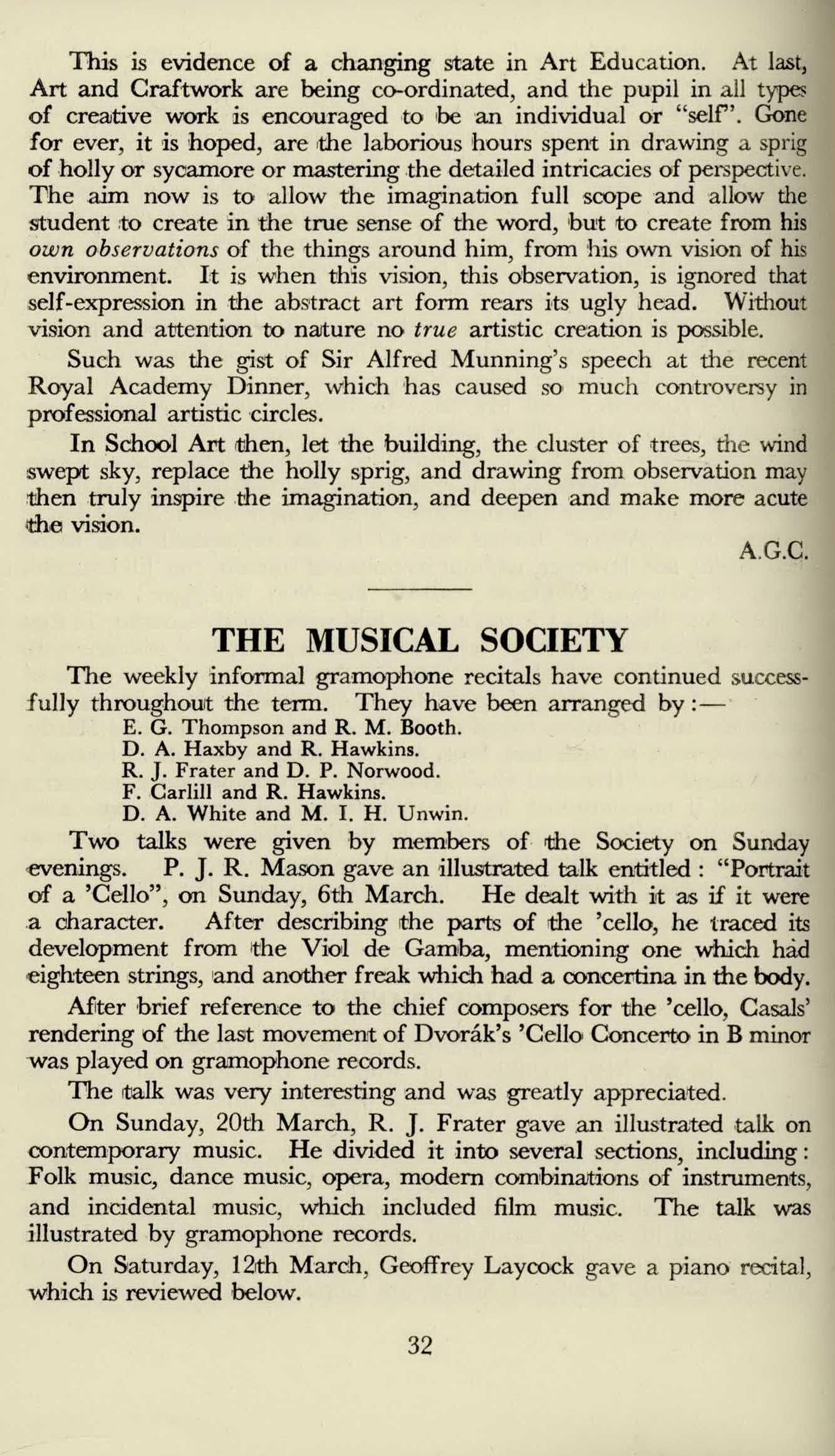
4 minute read
The Musical Society
from May 1949
by StPetersYork
This is evidence of a changing state in Art Education. At last, Art and Craftwork are being co-ordinated, and the pupil in all types of creative work is encouraged to be an individual or "self'. Gone for ever, it is hoped, are the laborious hours spent in drawing a sprig of holly or sycamore or mastering the detailed intricacies of perspective. The aim now is to allow the imagination full scope and allow the student to create in the true sense of the word, but to create from his own observations of the things around him, from his own vision of his environment. It is when this vision, this observation, is ignored that self-expression in the abstract art form rears its ugly head. Without vision and attention to nature no true artistic creation is possible.
Such was the gist of Sir Alfred Munning's speech at the recent Royal Academy Dinner, which has caused so much controversy in professional artistic circles.
In School Art then, let the building, the cluster of trees, the wind swept sky, replace the holly sprig, and drawing from observation may then truly inspire the imagination, and deepen and make more acute the vision.
A.G.C.
The weekly informal gramophone recitals have continued successfully throughout the term. They have been arranged by :-
E. G. Thompson and R. M. Booth. D. A. Haxby and R. Hawkins. R. J. Frater and D. P. Norwood. F. Carlill and R. Hawkins. D. A. White and M. I. H. Unwin.
Two talks were given by members of the Society on Sunday evenings. P. J. R. Mason gave an illustrated talk entitled : "Portrait of a 'Cello", on Sunday, 6th March. He dealt with it as if it were a character. After describing the parts of the 'cello, he traced its development from the Viol de Gamba, mentioning one which had eighteen strings, and another freak which had a concertina in the body.
After brief reference to the chief composers for the 'cello, Casals' rendering of the last movement of Dvorak's 'Cello Concerto in B minor was played on gramophone records.
The talk was very interesting and was greatly appreciated.
On Sunday, 20th March, R. J. Frater gave an illustrated talk on contemporary music. He divided it into several sections, including : Folk music, dance music, opera, modern combinations of instruments, and incidental music, which included film music. The talk was illustrated by gramophone records.
On Saturday, 12th March, Geoffrey Laycock gave a piano recital, which is reviewed below.
32
At 6 pm. on Saturday, 12th March, a considerable audience gathered in Big Hall to hear a Pianoforte Recital by Geoffrey Laycock, a promising young student from 'the Royal College of Music. The applause at its conclusion showed that the recital had been popular and evoked a charming encore in an arrangement of the Passepied from Delibes' "Le Roy s'amuse".
The programme was well varied, and although it lasted only 50 minutes contained examples of most of the styles in the current concert repertoke. Like many another recitalist, Mr. Laycock whetted our appetites by a piquant and sparkling performance of Scarlatti—the "Pastorale" on Tausig's arrangement. This was immediately followed by Beethoven's famous E flat major Sonata, Op. 31, No. 3, from which Saint Saens borrowed a theme for his popular two-piano variations, and which concluded the first half of the programme with its exuberant finale.
After the interval Mr. Laycock boldly retraced his steps and gave us Daquin's (1694-1772) "Coucou", where the characteristic falling third of the cuckoo is charmingly developed in true harpsicord style. From there we were suddenly transported to the brilliant early part of this century for De Severac's "Musical Box", whose many tinklings we found all too short.
Mr. Laycock, with his finger well on the pulse of musical taste at St. Peter's (as, indeed, at most other places of learning), concluded with a Chopin group. Honours were divided equally between the delicate embellishments of the oft-repeated bars on the Berceuse (68 times to be exact, with only slight modifications) and the scintillating study in G flat "on the black notes".
We are greatly indebted to Mr. Laycock for his well-executed playing and his inspired interpretation of the works he had chosen to play to us.

HAYDN'S "CREATION"
The School Orchestra and Choral Society presented parts of Haydn's "Creation" in Big Hall on Saturday, 12th February, before a mixed audience consisting of those members of the School who wished to attend, and parents and friends of the School.
The lay-out of orchestra and chorus was different from last year, the orchestra being on the left and centre and the chorus on the right. This was an attempt to get a better balance between the two, but the effect, at any rate from the seats by the left door of Big Hall, was of overwhelming treble tone, the broken voices of the chorus often being obscured by both trebles and orchestra.
33










